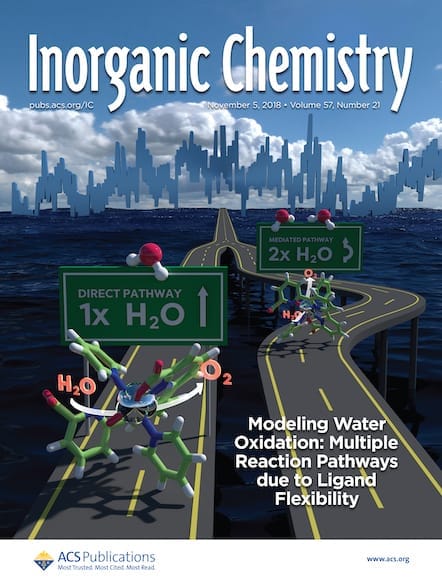Dr. Leroy (Lee) Cronin, the Regius Chair of Chemistry at the University of Glasgow, is the winner of the 2018 Inorganic Chemistry Lectureship.

Dr. Leroy (Lee) Cronin, the Regius Chair of Chemistry at the University of Glasgow, is the winner of the 2018 Inorganic Chemistry Lectureship. Inorganic Chemistry and the ACS Division of Inorganic Chemistry launched the award in 2013 to annually recognize an individual who has demonstrated creativity and impact in leading research in inorganic chemistry.
This award is being presented for Cronin and his group’s work on the self-assembly of protein-sized polyoxometalate molecules (metal-oxide clusters) and their electronic properties and applications. The approach includes programmable assembly of frameworks, and the group recently designed a robotic system to explore Human vs. Robots in the discovery and crystallization of gigantic polyoxometalates.
“The creativity and impact of Lee’s research is extraordinary,” said William (Bill) Tolman, Editor-in-Chief of Inorganic Chemistry. “A unique aspect is his group’s blending of fundamental inorganic chemistry with a wide range of multidisciplinary topics, including artificial intelligence approaches to chemical synthesis, 3-D printed hybrid materials and inorganic devices. I look forward to his lecture at the symposium to be held in his honor at the National ACS Meeting in Boston in August!”
As the winner of the 2017 Inorganic Chemistry Lectureship, Cronin will receive a $3,000 honorarium and travel expenses to attend and a present at a session in his honor at the 2018 ACS Fall National Meeting in Boston in August.
Cronin follows in the footsteps of five previous award winners:
- 2017 – Jonas C. Peters, Caltech
- 2016 – Serena DeBeer, Max Planck Institute for Chemical Energy Conversion
- 2015 – Daniel Gamelin, University of Washington
- 2014 – Jeffrey Long, University of California, Berkeley
- 2013 – Christopher Cummins, Massachusetts Institute of Technology
An Interview with Lee Cronin
I caught up with Cronin recently to learn more about his research and what he will be doing next. Here are the highlights of our conversation.
In inorganic chemistry, your group focuses on designing and preparing metal-based framework compounds—which often take on beautiful molecular shapes. Tell us a little about how you do this chemistry, and some of the important applications you are working on that will benefit society?
This chemistry is often done under one-pot conditions by working out how to control the self-assembly of these gigantic architectures using mass spectrometry, NMR, and then structure solution using single crystal X-ray crystallography. We try to incorporate heteroatom-based templates to control the redox chemistry, curvature, and ability to bind other metal ions, as well as to derivatize them using organic moieties.
Many interesting applications arise from the fundamental questions we can ask, which range from how does self-assembly really work to how many electrons can be stored on the clusters? In terms of real-world applications, applications include the use of these systems in energy storage, catalysis, and the development of inorganic metal oxide molecules that can be integrated into solid-state electronic devices.
You have a rather large research group that focuses on a broad swath of science and engineering, including energy applications, robotics, and even three-dimensional printing. Tell us a little about your research philosophy and how you manage to lead such a prolific research operation—how do the eclectic topics of your research build off each other?
This is a big question. My objective is to be problem led, and although I’m an inorganic chemist, I don’t see myself limited to any one area. Instead, I feel uniquely prepared since inorganic chemists have to be open to many different avenues and ideas.
One of my key goals is to imagine how an ‘all-inorganic’ life form might be discovered/constructed/emerged, and this inspires me to explore complexity in inorganic chemistry. To do this properly, we had to build new kits for the automation of chemical systems in terms of synthesis, exploration, and the use of artificial intelligence (AI) in chemistry.
What’s next in your research?
The use of highly complex AI-data analysis routines to explore complex chemical systems, to look for patterns in many-dimensional data sets, and the construction and use of chemical robots for exploration, synthesis, and method development.
Is there anything else you’d like to share?
We are inspired by the crystallographic studies that have elucidated the molecular structure of some gigantic inorganic molecular structures and are currently trying to explore how we can drop the symmetry, increase complexity, and perhaps engineer a new way to produce functional inorganic protein-sized molecules.
A Selection of Lee Cronin’s Inorganic Chemistry Articles
Get an idea of Cronin’s research in this selection of articles he has published in Inorganic Chemistry and other ACS Publications journals:
Coding the Assembly of Polyoxotungstates with a Programmable Reaction System
Inorg. Chem., 2017, 56 (9), pp 5089–5095
DOI: 10.1021/acs.inorgchem.7b00206
Synthesis and Characterization of a Series of [M2(β-SiW8O31)2]n− Clusters and Mechanistic Insight into the Reorganization of {β-SiW8O31} into {α-SiW9O34}
Inorg. Chem., 2015, 54 (8), pp 4151–4155
DOI: 10.1021/acs.inorgchem.5b00405
Read all of Lee Cronin’s articles in ACS Publications journals.
